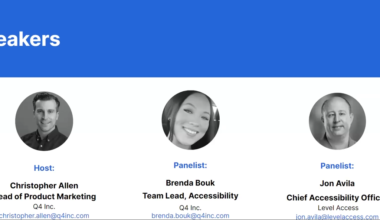Accessibility is ever-evolving but an essential aspect of digital inclusion that is important for every company to consider as they develop their web presence. As Investor Relations continue to experience a seismic shift to virtual, it is especially crucial for your IR website to have digital inclusion and compliance.
The importance of digital inclusion
Accessibility focuses on ensuring there are no barriers to providing an equivalent user experience to all, regardless of ability or the way people access technology. There are many types of disabilities that can affect users–visual, auditory, motor, cognitive, and speech–and due to this vast range, visitors can encounter several barriers while accessing your website. The goal is to make your website’s user experience inclusive and straightforward, not only because it’s the law but because you want everyone to access the tools and services you provide, challenge-free.
What is the significance of accessibility specifically for investor relations? Your IR website is the most trusted source of information for investors, and their experience navigating it is vital to your business relationship. This is especially true today due to the aforementioned shift to virtual engagement accelerated by the pandemic. While speaking in person can certainly have its challenges–especially for those with disabilities – it is your responsibility as a business to ensure the transition to virtual is as smooth and accessible as possible for everyone. Because there are currently 1.3 billion people living with disabilities, we must assume that a portion of our users is among that population.
Digital inclusion guidelines
The laws and regulations often differ between jurisdictions, but the most widely known are the ADA (American with Disabilities Act), the AODA (Accessibility for Ontarians with Disabilities Act), EN 301 549: The European Standard for Digital Accessibility, the Equality Act, and the EAA (European Accessibility Act). Although they vary in some aspects, the main commonality is that they all point to international technical standards for digital accessibility called WCAG (the Web Content Accessibility Guidelines), which is a set of guidelines for the design and development of digital platforms to bring uniformity across the web. Regardless of where you are in the world, your local laws will always point to this set of guidelines.
In a survey conducted by WebAIM, 1 million people were asked about the most common accessibility failures (or barriers) they experienced, and the results were as follows:
- Low contrast text
- Missing alt text
- Missing form labels
- Empty links
- Missing document language
- Empty buttons
In fact, 97.7% of all errors detected fall into these categories. It’s your responsibility to incorporate accessibility thinking and execution into every aspect of your workflows and to constantly monitor your website and digital properties for potential issues. Keep in mind that due to changing content, evolving standards, differentiation between groups of disabilities within the population, etc., we will never be 100% accessible – but we should always try to strive to conform.
Next steps
We recommend building your foundation on an accessible website template, proactively monitoring and maintaining your accessible website with the Q4 and Level Access partnership, and working with your Q4 CSM on your long-term remediation strategy.


